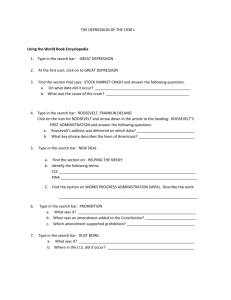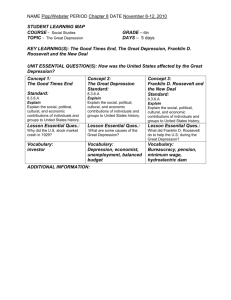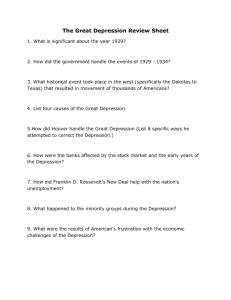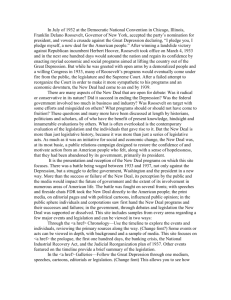Great Depression Classwork - Scarsdale Union Free School District
advertisement
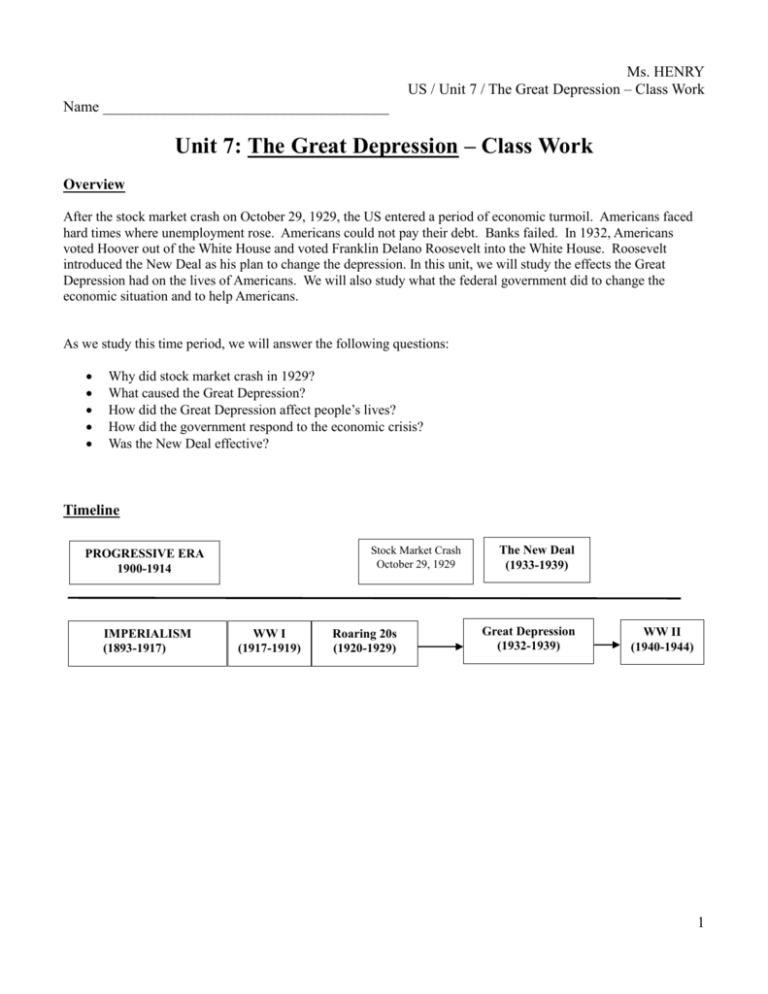
Ms. HENRY US / Unit 7 / The Great Depression – Class Work Name ______________________________________ Unit 7: The Great Depression – Class Work Overview After the stock market crash on October 29, 1929, the US entered a period of economic turmoil. Americans faced hard times where unemployment rose. Americans could not pay their debt. Banks failed. In 1932, Americans voted Hoover out of the White House and voted Franklin Delano Roosevelt into the White House. Roosevelt introduced the New Deal as his plan to change the depression. In this unit, we will study the effects the Great Depression had on the lives of Americans. We will also study what the federal government did to change the economic situation and to help Americans. As we study this time period, we will answer the following questions: Why did stock market crash in 1929? What caused the Great Depression? How did the Great Depression affect people’s lives? How did the government respond to the economic crisis? Was the New Deal effective? Timeline Stock Market Crash October 29, 1929 PROGRESSIVE ERA 1900-1914 IMPERIALISM (1893-1917) WW I (1917-1919) Roaring 20s (1920-1929) The New Deal (1933-1939) Great Depression (1932-1939) WW II (1940-1944) 1 Causes of the Great Depression Stock Market Crash of 1929 What is a stock market? What is a “stock market crash”? People want to sell their shares, People can own a piece but no one wants buy those or a share of a shares corporation Stock Market is where Value, or price, of shares decreases those shares are traded Volume of the market decreases What caused the stock market to crash on October 29, 1929? Speculation: making a financial investment without the guaranteed return of your investment o During the 1920s many people speculated they made investments that did not guarantee a return, Example: the stock market Debt: when you borrow money and you owe it to back 2 o During the 1920s many people borrowed money to make stock purchases Buying on Margin o When a person is not able to pay his debt, both the lender and the borrower lose. If someone doesn’t repay his debt, the lender is out that money too. How did the crash of the stock market contribute to the Great Depression? Some people, but not everyone, lost money o When some people lost money, they couldn’t pay their debts When people couldn’t pay their debt, the lenders lost money It’s a bad cycle Was the crash of the stock market the only cause of the Great Depression? No there were many factors Global Depression: The United States was not the only nation that experienced an economic downturn. Europe nations had tremendous debt following World War I. World trade declined during the 1920s. How do economic problems in other nations affect the US? The US couldn’t collect the Europeans war debt so US lost 3 money Other nations couldn’t buy American goods so the US lost money Tariffs: taxes on goods imported from other countries o US raised tariffs to encourage Americans to buy American goods to stimulate the economy o Only increased the effects of the depression around the world Banking Crisis: “run on banks” Why were people “running to the banks”? Banks use the money people put in savings to lend out People who lost money in the stock market couldn’t pay their debt to the bank Banks didn’t have money for people who wanted to get their savings out of the bank Business Failures: In 1930s more than 26,000 businesses went bankrupt. Define bankrupt: When a business can’t pay its debt and therefore the business has to close 4 How did the failure of business affect the economy? When business close, they can’t employ people; people lose their jobs o Unemployment rises Unemployment: In 1929, approximately 3% of Americans were unemployed. In 1932, nearly 25% of Americans were unemployed. How did high unemployment affect the economy? When people lose their jobs, their don’t have money to buy goods o When people can’t buy goods, more business who sell goods go bankrupt and fail What are these men waiting for? Why? FREE coffee and doughnuts Because they are unemployed and can’t afford people Charitable organizations would hand out break or other food to out of work Americans Falling Crop Prices: People throughout America could not afford food. Farmers were left 5 with unsold surplus of crops. Cotton prices dropped from 16 cents in 1929 to 6 cents in 1931. How did falling crop prices and unsold crops affect the economy? Because price crops dropped, farmers couldn’t make enough money from selling their crops. Farmers couldn’t pay their debts and lost their farmers How did President Hoover plan to deal with the economic crisis? He thought charities should take care of people 6 What was a hooverville? Communities of people living in tents Why were people living in hoovervilles? Unemployed people lost their homes and lived in temporary shelter == tents How did Americans feel about Hoover? People blamed Hoover for the economic situation and blamed him for not fixing the economic problems Children protesting during the Bonus March Hard Times How did the economic crisis affect people’s daily lives? People lost their jobs People lost their homes People could afford food to eat 7 How does this woman appear? SAD What do notice about her clothing? It’s dirty and torn What do you notice about her children? They hide their faces from the camera They lean on their mother They seem sad or ashamed 8 DISCONTENT: Bonus Army: 10,000 World War I veterans and their families marched in Washington DC. The Veterans were demonstrating support for a bill to grant veterans early payment of the pension bonuses owed from their service during the war. The bill was defeated. During the Bonus Army’s demonstration, veterans camped out in hoovervilles and empty office buildings in DC. After the defeat of the bill, 2,000 of the Bonus army remained in DC and refused to leave. President Hoover used the army to vacate the squatters. “My husband went to Washington. To march with . . .the bonus boys. He was a machine gunner in the war. He’d say . . . Germans gassed him in Germany. And his own government . . . gassed him and run him off the country up there with a water hose, half drowned him.” --- Wife of Bonus Army member, quoted in Hard Times by Studs Terkel From this woman’s statement, what methods did the army use to get rid of the Bonus army protesters? Water cannon, gas, 9 Are their methods shocking? Why? You don’t expect the US government to treat veterans this way. You expect the government to treat veterans with respect. Who is elected President in 1932? Franklin Delano Roosevelt What does this map show? The election results from the 1932 election 10 From looking at the map, how would you describe Roosevelt’s victory in the election? FDR won by a landslide --- an overwhelming victory “First of all, let me assert my firm belief that the only thing we have to fear is fear itself – . . . The people of the United States have not failed. In their need they have registered a mandate that they want direct, vigorous action.” Franklin Roosevelt First Inaugural Address, 1933 During the Great Depression, what do Americans fear? Poverty, unemployment, losing their homes, being unable to provide for themselves and their family Why does Roosevelt say “the only thing we have to fear is fear itself” mean? Americans don’t have to be afraid of poverty because help is on the way What is Roosevelt trying to inspire in the American people? Confidence in America Confidence in the government Confidence in his plan to fix the economic situation THE NEW DEAL Roosevelt promised “a new deal for the American people.” During the first 100 days of his Presidency, Congress passed an unprecedented number of laws. Congress passed every measure that Roosevelt asked for. First New Deal: Primarily Programs that provided relief for Great Depression problems. The Emergency Banking Act: Roosevelt temporarily closed all the banks in the nation creating a “bank holiday” until the government inspected the banks to assure that they were financially sound. Made federal loans available to banks. 11 Federal Deposit Insurance Corporation: the federal government insures that the deposits you have in the bank. So if you went to take you money from the bank, you would get exactly that amount. Which problem of the Great Depression were these laws meant to relieve? Run on banks Banks not having money to pay to people who wanted to make withdrawals Civilian Conservation Corp: employed men ages 17-23 to plant trees, build roads, other conservation projects. What problem of the Great Depression was this meant to relieve? Unemployment and poverty CCC: Put young men to work their checks went directly to their parents Agricultural Readjustment Act: paid farmers subsidies not to plant crops and to kill livestock. What problem of the Great Depression was this meant to relieve? Falling crop prices Farms losing their farms 12 Tennessee Valley Authority (TVA): A government owned corporation that created economic development in the Tennessee Valley region. This region of the United States was economically troubled before the depression and suffered greatly during the Great Depression. The TVA provided economic opportunity by building dams, generating electricity, manufacturing and providing fertilizers, and conservation projects in region. What problem of the Great Depression was the TVA meant to relieve? Specific relief in the area of the Tennessee valley Relieve poverty, unemployment and farming trouble in the area How is the TVA different from other New Deal Programs? TVA was not nation wide It only helped the Tennessee Valley region Second New Deal: Programs that tried to REFORM Works Progress Administration: (WPA) employed millions of unskilled laborers in building, art and improvement projects. The WPA employed artists in various works painting, sculpting and writing. What problem of the Great Depression was the WPA meant to reform? Generate more employment for unskilled laborers and artist Improve infrastructure in the country 13 National Labor Relations Act (NLRA): law protects works engaged in collective bargaining and strikes. The law protected unions from interference from employers. What problem of the Great Depression was the NLRA meant to reform? Help works to unionize Protect unions Unions protect labors Social Security Act: Provided pensions for elderly, unemployment compensation and disability benefits. What problem of the Great Depression was the Social Security Act meant to reform? Force people to save for retirement, provide security (a check) for the unemployed, provide security (a check) for the disabled Describe the cartoon? Uncle Sam – America – is the old man who is sick Congress is his wife who called the doctor FDR is supposed to be a doctor Bottle on the table have the initials of various New Deal programs 14 What criticism is the cartoon making of the New Deal? None of these New Deal programs has cured America of the Great Depression FDR just keep trying new things In his inaugural address, Roosevelt suggested that a temporary departure from “the normal balance of executive and legislative power” might be necessary and that he would ask Congress for “broad Executive Power to wage a war against the emergency. How does that describe the New Deal? Congress enacts whatever law or programs the President proposes Why is an imbalance of power between the executive and legislative a problem? The Constitution provides for checks and balances If there is an imbalance of power between the executive and legislative – that is unconstitutional Is the New Deal Constitutional? Opponents of the New Deal challenged these laws in court. When the cases came before the Supreme Court, the Court overturned some New Deal legislation – finding each law unconstitutional. What was Roosevelt’s plan to protect the New Deal from being overturned by the Supreme Court? He proposed adding new justices to the court (changing the number o There are 9 Supreme Court Justices o Each Justice is appointed for life (until death or he chooses to retire) How would “court packing” protect the New Deal? o The president gets to nominate the justices to the Supreme Court o FDR would nominate judges favorable to the New Deal so that no more New Deal legislation would be found unconstitutional How did Congress respond to Roosevelt’s plan? Members of Congress, both Republican and Democrat, opposed the court packing plan 15 How did the Supreme Court respond? The Judges stopped finding New Deal Programs unconstitutional 16


